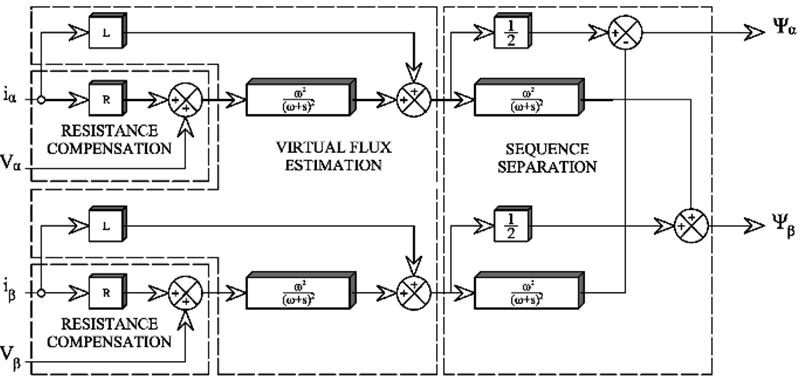A power quality enhanced for the wind turbine with sensorless direct power control under different input voltage conditions
DOI:
https://doi.org/10.20998/2074-272X.2021.6.09Keywords:
direct power control, virtual flux, grid voltage modulated, constant switching frequencyAbstract
Introduction. The quality of electrical energy is essential during disturbances, at the level of power electronic devices will suffer serious operating problems causing dangerous damage. Aim. A new approach to direct power control without grid voltage sensor improves the quality and control of instantaneous active and reactive power converters. Methodology. First, the technique without network voltage sensor with a direct power control based on a switching table, which is a classic approach, is discussed and its performance is analyzed under increasing and decreasing load. In addition, the performance of the proposed technique is also analyzed under the same circumstances and their performance is compared. Originality. The new method consists of a nonlinear grid voltage modulated controller and a conventional controller which guarantees very good results in a polluted network. The proposed method is verified using MATLAB/Simulink. Results. The simulation results under different input voltage conditions show that the proposed method not only has good tracking performance in active and reactive power, but also reduces the current total harmonic distortion to 1.9 %, which is good lower than the requirement for network operation.
References
Bayoumi E.H.E. Power electronics in smart grid power transmission systems: a review. International Journal of Industrial Electronics and Drives, 2015, vol. 2, no. 2, p. 98. doi: https://doi.org/10.1504/ijied.2015.069784.
Akagi H., Watanabe E.H., Aredes M. The Instantaneous Power Theory. In Instantaneous Power Theory and Applications to Power Conditioning (eds H. Akagi, E.H. Watanabe and M. Aredes). 2017. doi: https://doi.org/10.1002/9780470118931.ch3.
Depenbrock M. Direct self-control of the flux and rotary moment of a rotary-field machine. US Patent no. 4678248A, Jul. 07, 1987. Available at: https://patentimages.storage.googleapis.com/89/13/c0/9d04c667c8003f/US4678248.pdf (accessed 14 March 2021).
Yousefi-Talouki A., Zalzar S., Pouresmaeil E. Direct Power Control of Matrix Converter-Fed DFIG with Fixed Switching Frequency. Sustainability, 2019, vol. 11, no. 9, p. 2604. doi: https://doi.org/10.3390/su11092604.
Berkani A., Bey M., Araria R., Allaoui T. A new approach based on Fuzzy-Q-Learning algorithm to control 3 level T-type voltage source converter. Journal Européen des Systèmes Automatisés, 2020, vol. 53, no. 6, pp. 845-852. doi: https://doi.org/10.18280/jesa.530610.
Chaoui A., Gaubert J.-P., Krim F. Power quality improvement using DPC controlled three-phase shunt active filter. Electric Power Systems Research, 2010, vol. 80, no. 6, pp. 657-666. doi: https://doi.org/10.1016/j.epsr.2009.10.020.
Laggoun Z.E.Z., Khalile N., Benalla H. A Comparative study between DPC-SVM and PDPC-SVM. 2019 International Conference on Advanced Electrical Engineering (ICAEE), 2019, pp. 1-5. doi: https://doi.org/10.1109/ICAEE47123.2019.9014796.
Malinowski M., Jasinski M., Kazmierkowski M.P. Simple direct power control of three-phase PWM rectifier using space-vector modulation (DPC-SVM). IEEE Transactions on Industrial Electronics, 2004, vol. 51, no. 2, pp. 447-454. doi: https://doi.org/10.1109/TIE.2004.825278.
Shang L., Hu J. Sliding-Mode-Based Direct Power Control of Grid-Connected Wind-Turbine-Driven Doubly Fed Induction Generators Under Unbalanced Grid Voltage Conditions. IEEE Transactions on Energy Conversion, 2012, vol. 27, no. 2, pp. 362-373. doi: https://doi.org/10.1109/TEC.2011.2180389.
Wai R., Yang Y. Design of Backstepping Direct Power Control for Three-Phase PWM Rectifier. IEEE Transactions on Industry Applications, 2019, vol. 55, no. 3, pp. 3160-3173. doi: https://doi.org/10.1109/TIA.2019.2893832.
Bouafia A., Gaubert J., Krim F. Predictive Direct Power Control of Three-Phase Pulsewidth Modulation (PWM) Rectifier Using Space-Vector Modulation (SVM). IEEE Transactions on Power Electronics, 2010, vol. 25, no. 1, pp. 228-236. doi: https://doi.org/10.1109/TPEL.2009.2028731.
Norniella J.G., Cano J.M., Orcajo G.A., Rojas C.H., Pedrayes J.F., Cabanas M.F., Melero M.G. Multiple switching tables direct power control of active front‐end rectifiers. IET Power Electronics, 2014, vol. 7, no. 6, pp. 1578-1589. doi: https://doi.org/10.1049/iet-pel.2013.0492.
Tao Y., Wu Q., Wang L., Tang W. Voltage sensorless predictive direct power control of three‐phase PWM converters. IET Power Electronics, 2016, vol. 9, no. 5, pp. 1009-1018. doi: https://doi.org/10.1049/iet-pel.2014.0713.
Suul J.A., Luna A., Rodríguez P., Undeland T. Virtual-Flux-Based Voltage-Sensor-Less Power Control for Unbalanced Grid Conditions. IEEE Transactions on Power Electronics, 2012, vol. 27, no. 9, pp. 4071-4087. doi: https://doi.org/10.1109/TPEL.2012.2190301.
Ketzer M.B., Jacobina C.B. Virtual Flux Sensorless Control for Shunt Active Power Filters With Quasi-Resonant Compensators. IEEE Transactions on Power Electronics, 2016, vol. 31, no. 7, pp. 4818-4830. doi: https://doi.org/10.1109/TPEL.2015.2487298.
Laggoun Z.E.Z., Benalla H., Nebti K. Dual Virtual Flux-based Direct Power Control for rectifier under harmonically distorted voltage condition. Archives of Electrical Engineering, 2020, vol. 69, no. 4, pp. 951-966. doi: https://doi.org/10.24425/aee.2020.134641.
Gui Y., Kim C., Chung C.C., Guerrero J.M., Guan Y., Vasquez J.C. Improved Direct Power Control for Grid-Connected Voltage Source Converters. IEEE Transactions on Industrial Electronics, 2018, vol. 65, no. 10, pp. 8041-8051. doi: https://doi.org/10.1109/TIE.2018.2801835.

Downloads
Published
How to Cite
Issue
Section
License
Copyright (c) 2021 Z.E.Z. Laggoun, H. Benalla, K. Nebti

This work is licensed under a Creative Commons Attribution-NonCommercial 4.0 International License.
Authors who publish with this journal agree to the following terms:
1. Authors retain copyright and grant the journal right of first publication with the work simultaneously licensed under a Creative Commons Attribution License that allows others to share the work with an acknowledgement of the work's authorship and initial publication in this journal.
2. Authors are able to enter into separate, additional contractual arrangements for the non-exclusive distribution of the journal's published version of the work (e.g., post it to an institutional repository or publish it in a book), with an acknowledgement of its initial publication in this journal.
3. Authors are permitted and encouraged to post their work online (e.g., in institutional repositories or on their website) prior to and during the submission process, as it can lead to productive exchanges, as well as earlier and greater citation of published work.




